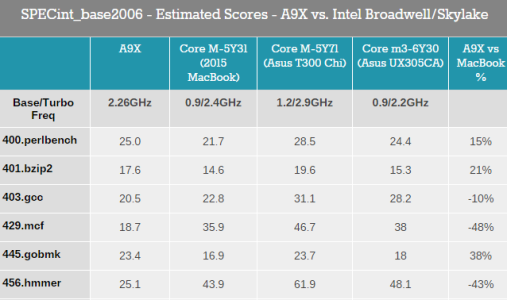As i said, emulation is just an enabling technology. ARM devices are not supposed to run x86 apps better than an x86 architecture. However these devices are supposed to run native ARM Win32 apps better with respect to perf/watt than x86 machines.
This we can put aside. We agree that the goal must be to offer the same program compiled for ARM and x86. Any scenario where emulating x86 remains the norm on ARM devices would utterly destroy any supposed advantage ARM may have. As you said, emulation is an enabling technology (I prefer the term "stop-gap measure"). Nothing more.
Where has anyone stated that "all we want to run ins x86 apps"? I definitely didn't say that. I don't think anybody else did either. I have no idea why you'd think that represents my point of view.
It was the premise from which you implied that there are better ways. My argument was, that your premise was wrong.
It was never the premise. Please stop putting words in my mouth.
here is not a single Core-M chip available i would buy for a tablet. These things have to be put into hibernation in order to hold the battery for more than a day. ARM chips you can leave in stand-by for days. Likewise if you limit Core-M to low TDP, voltage is reduced and frequency is severely throttled such there is not much left of the supposed performance advantage.
Nowhere did I say that Core-M has a
general performance advantage. Again, please stop putting words in my mouth. I said Core-M and high-end Snapdragon are comparable in terms of performance. Comparable means "more or less the same". Not that one has an advantage. The only exception is when it comes to running x86 software, where an ARM device must shoulder the emulation overhead. In that specific scenario, and only then, does Core-M have an across-the-board advantage (battery-life, perf/watt, raw performance, etc... everything).
Furthermore, your information is outdated. Just like ARMs and Atoms, the latest Core-M chips all include connected standby capabilities (the normal Intel Core chips too). Windows recently gained support for this with something MS calls "Modern Standby". A tablet built with the latest Core-M CPU can also be left in standby for days.
No difference!
Assuming for a moment my technical arguments are sound - they cannot forever support an outdated and inefficient architecture exclusively without risking to become irrelevant.
You do realize that ARM was around back in the 1980's, right? Both ISAs are ancient.
It sounds as if you think ARM is an objectively superior, almost magical ISA compared to x86. It's not. Intel and ARM just approach the problem from different angles. An IC can be designed to perform as well as possible (most of what Intel does), or it can be designed to be as power efficient as possible (most of what ARM does). Both requirements are mutually exclusive. Between those two extremes, a company can take the approach to maximize perf/watt, in which case neither best performance or lowest power consumption is top priority, but best bang for your power. Designs built on that last approach is where both company's products are slowly converging and becoming ever more comparable.
To be honest, ARM's original designs actually suck at this point. ARM's technology is now only competitive when put into the hands of companies like Qualcomm or Apple. It's not really about the ISA at all, but rather about the specific CPU designs built around those ISAs by Intel, Qualcomm, Apple and Samsung.
They are not even close to comparable. In the same power envelope Intel is so far behind, it is not even funny.
Really? We seem to both agree that Apple has (IMHO by far) the best ARM implementation around. So lets compare Apple's ARM A9X, to Intels x86 Core M 6Y30, as both have a similar TDP rating and both are produced on a 14nm process node:
 source
source
The A9X and the somewhat older m3-6Y30 go back and forth. Where Core-M is better, it's significantly better, but the A9X also pulls out a few wins. If we don't want to give the win to Intel, I'd say the results are roughly comparable. As far as I'm concerned, that's the end of your argument. The idea that the x86
ISA is outdated and inefficient is ridiculous. The designs used to implement x86 and ARM compatible CPUs have undergone radical changes over time and have been kept up to date and modern. They all employ similar concepts. Only the ISA is different which barely matters anymore.
I suspect that going forward, Apple and Intel will continually wrestle over performance leadership, continually switching first and second spots based on whomever was the latest to release a product to market.
I'll say it just one more time and them I'm out:
If the goal is to
also run x86 software, there is, purely from a performance perspective, simply no reason to accept emulation on ARM. We're far better off using a Core M chip. Using the newest iterations of both chips, battery life will be similar and performance will be very comparable, except when running x86 software, where Core M will do much better. If we start to judge other metrics beside pure performance, particularly price, then the ARM alternatives start to make a lot more sense. From what I've been reading, all OEMs are coming to that conclusion. Intel seems to be pricing Core M out of the market.



